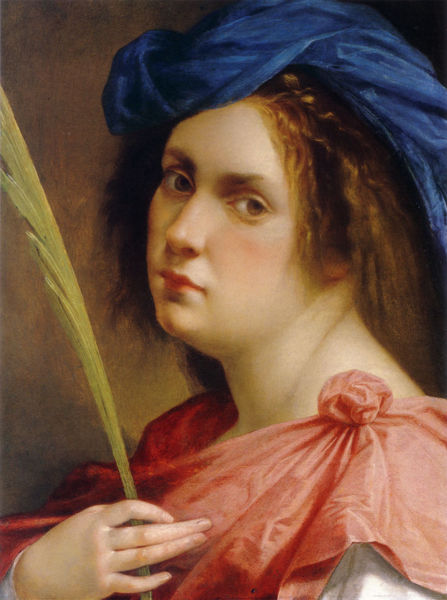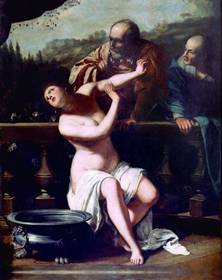Artemisia Gentileschi
 accomplished painters in the generation influenced by Caravaggio. She was the first female painter to become a member of the Accademia di Arte del Disegno in Florence. She was one of the first female artists to paint historical and religious paintings, at a time when such heroic themes were considered beyond a woman’s reach.
accomplished painters in the generation influenced by Caravaggio. She was the first female painter to become a member of the Accademia di Arte del Disegno in Florence. She was one of the first female artists to paint historical and religious paintings, at a time when such heroic themes were considered beyond a woman’s reach.
Early Life and Education
Artemisia Gentileschi was born in Rome, the first child of the painter Orazio Gentileschi, one of the best representatives of the school of Caravaggio. Artemisia was introduced to painting in her father’s workshop, where she learned drawing, how to mix color and how to paint. She too was heavily influenced and inspired by Caravaggio.
Her first work, completed at the age of 17, was Susanna e i Vecchioni (Susanna and the Elders). Despite evidence of her early talent, she was rejected from the all-male professional academies for art on account of her gender.
Rape and Trial
Her father hired fellow artist, Agostino Tassi, to tutor his daughter privately. Tassi raped Artemisia, helped by Cosimo Quorlis. After the initial rape , Artemisia continued to have sexual relations with Tassi, since he promised to marry her. However, unbeknownst to Artemisia, he was already married. Orazio pressed charges against Tassi only after he learned that Artemisia and Tassi were not going to be married. Orazio also claimed that Tassi stole a painting of Judith from the Gentileschi household. The major issue of this trial was the fact that Artemisia had lost her virginity to Tassi.
In the ensuing 7-month trial, Artemisia was given a gynecological examination and was tortured using a device made of thongs wrapped around the fingers and tightened by degrees. Both procedures were used to corroborate the truth of her allegation, the torture device used due to the belief that if a person can tell the same story under torture as without it, the story must be true. At the end of the trial Tassi was imprisoned for one year.
The painting Giuditta che decapita Oloferne (Judith beheading Holofernes) (1612 – 1613), has been interpreted as a wish for psychological revenge for the violence Artemisia had suffered.
Marriage and Florence
In order to restore her honor, Orazio arranged for his daughter to marry Pierantonio Stiattesi, a Florentine artist. After  moving to Florence, Artemisia received a commission for a painting at Casa Buonarroti and became a successful court painter, enjoying the patronage of the Medici family and Charles I. While in Florence, Artemisia and Pierantonio had four sons and one daughter, although only the daughter survived to adulthood.
moving to Florence, Artemisia received a commission for a painting at Casa Buonarroti and became a successful court painter, enjoying the patronage of the Medici family and Charles I. While in Florence, Artemisia and Pierantonio had four sons and one daughter, although only the daughter survived to adulthood.
Artemisia was the first woman accepted into the Accademia del Disegno (Academy of Drawing). She frequented an influential circle which included Granduke Cosimo II de’ Medici, Granduchess Cristina, Galileo Galilei and Michelangelo Buonarroti the younger (nephew of the great Michelangelo).
Notable works from this period include La Conversione della Maddalena (The Conversion of the Magdalene), and Giuditta con la sua ancella (Judith and her Maidservant). Artemisia painted a second version of Giuditta che decapita Oloferne (Judith beheading Holofernes). Despite her success, due to an excess of expenses by her husband, the Florentine period was full of problems with creditors and with her husband. These problems led to her return to Rome in 1621.
Rome Period
Despite her artistic reputation, Artemisia did not reach the summits of success in Rome that she had experienced in Florence. The appreciation of her art was narrowed down to portraits and to her ability with biblical heroines: she received none of the lucrative commissions for altarpieces. By 1627, she moved to Venice in search of more favourable working conditions.
The following were probably painted in this period in Rome and Venice: the Ritratto di gonfaloniere (Portrait of Gonfaloniere); the Giuditta con la sua ancella, (Judith and her Maidservant); Venere Dormiente (The Sleeping Venus); Ester ed Assuero (Esther and Ahasuerus).
Naples and England 1630-1653
In 1630 Artemisia moved to Naples, where she remained for the rest of her career with the exception of a brief trip to London and some other journeys. In Naples for the first time Artemisia started working on paintings in a cathedral, dedicated to San Gennaro nell’anfiteatro di Pozzuoli (Saint Januarius in the amphitheater of Pozzuoli) in Pozzuoli. During her first Neapolitan period she painted Nascita di San Giovanni Battista (Birth of Saint John the Baptist) and Corisca e il satiro (Corisca and the satyr).
In 1638 Artemisia joined her father in London at the court of Charles I of England, where Orazio became court painter and received the important job of decorating a ceiling (allegory of Trionfo della pace e delle Arti (Triumph of the peace and the Arts) in the Casa delle Delizie of Queen Henrietta Maria of France in Greenwich. Charles I had convoked her in his court, and it was not possible to refuse.
Orazio suddenly died in 1639. It is known that Artemisia had already left England by 1642, when the civil war was just starting. Her movements are then difficult to trace although it is known from a letter written to her mentor, Don Antonio Ruffo of Sicily, that she was in Naples by 1649. She was still receiving commissions in 1654, although relying on her assistant to help her complete them. It is quite likely that she died during the plague that hit Naples in 1656.
Some works in this period are Susanna e i vecchioni (Susanna and the elders) and Madonna e Bambino con rosario (Virgin and Child with a Rosary).
Artemisia Gentileschi and 20th Century Feminism
During the 70s, Artemisia Gentileschi’s attracted the attention of Feminism , who retraced her authorship of paintings which had lost its original attribution over the centuries. The rape and trial have also attracted cosiderable attention, resulting in a controversial French film in 1999, Artemisia, which depicted the rape as consensual.
Sources
- http://www.artemisia-gentileschi.com/index.shtml
- http://en.wikipedia.org/wiki/Artemisia_Gentileschi
- http://sisyphe.org/article.php3?id_article=995


